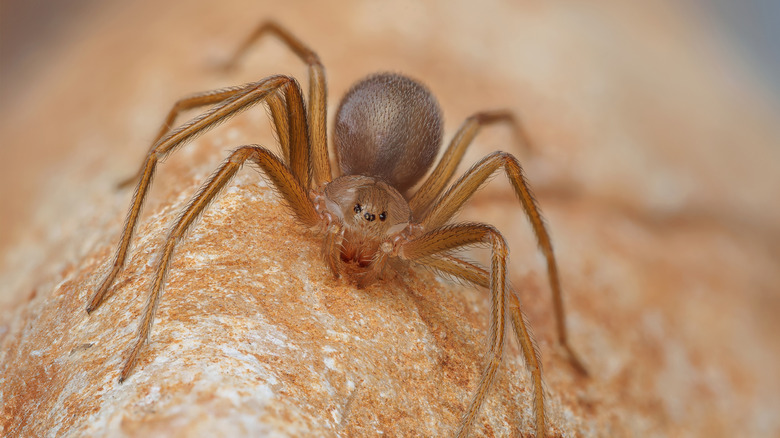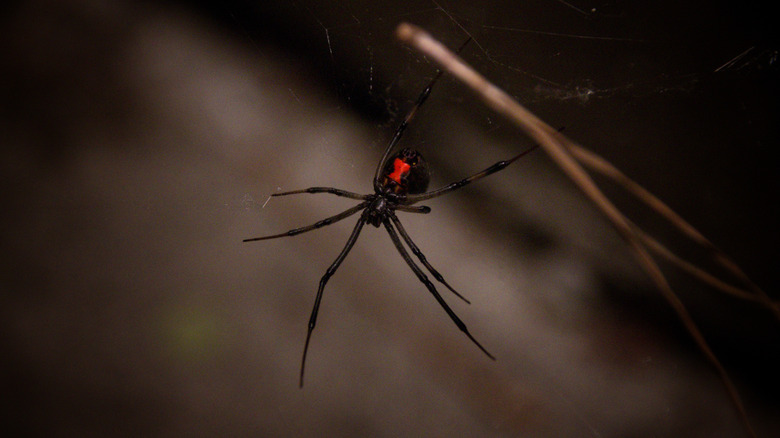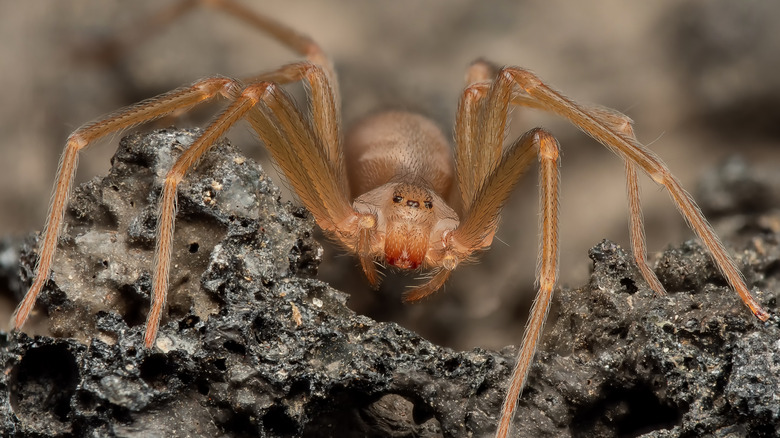The Two Spiders You Absolutely Do Not Want To Find In Your Garden Or Yard
Spiders have a worse reputation than they deserve. After all, you'll find plenty of these reviled creatures in the healthiest ecosystems because they serve valuable roles. For instance, they protect gardens from aphids, beetles, and caterpillars. They also eat disease-carriers like mosquitoes and flies. Most of the disgust people have for spiders seems to come from the way they look, with pointed legs and hauntingly inexpressive eyes like a string a black stones. But, for the most part, spiders cannot harm people. Of the more than 3,700 spider species in the United States, brown recluses (Loxosceles reclusa) and black widows (Latrodectus hesperus) are the most venomous. Apologies to arachnophobes, but depending on where you live, these species might be in your yard, or even your house.
The country is home to 11 native brown recluse species, which are established in states throughout the South and Southwest. There are five widow species (three of which are black) that cover 49 states. The bites of either species often make people sick and can even be lethal in exceptionally rare cases. Although there are thousands of reported bites a year, deaths are rare. The last death from a black widow bite was in 1983, and there have only been a handful of deaths from brown recluse bites in the 21st century. Children, the elderly, and pets have the highest risk of serious illness if bitten. That's why it's important to keep venomous spiders off your property or at least be aware of their hideouts.
How to find brown recluses and black widows in your yard
The first step for locating venomous species is knowing what they look like. Black widows are the easiest to identify. Only female black widows are considered dangerous, and they have one of the most distinct and memorable appearances of any arachnid. They are jet black and have bulbous abdomens with a hallmark red hourglass shape on the underside. Female black widows also tend to reach a full size of about a quarter inch to three-quarters of an inch. The males are brown, tend to be smaller, and have smaller venom glands.
Both male and female brown recluses are venomous, but the females carry more venom while the males bite more often. The males have thick pedipalps, which are leg-like appendages near the mouth. Female brown recluses also have pedipalps, but they are much smaller. The other key difference is size. Female brown recluses mature to about a quarter inch to half an inch, while males grow to about half the average size. Regardless of sex, brown recluses have three sets of eyes and violin-shaped marks on their backs. It is very easy to mistake wolf spiders, which are harmless, for brown recluses. The difference is that wolf spiders have eight eyes, striped patterns, and grow to be much larger.
Black widows and brown recluses like to hang out in similar places. They both prefer warm, dry shelters like woodpiles, attics, storage boxes, dog houses, and tree houses. Make sure you wear gloves next time you're dusting those spots for cobwebs. These species create messy, unstructured webs. Both spiders are common from late spring through October, but it's still a good idea to check likely spaces periodically during the warmer seasons. They are two of the most likely spiders to live in your home.
How to respond to a venomous spider bite
When a black widow sinks its fangs in, you may feel a slight stinging or nothing at all. Within an hour, the bite spot will turn red and start to swell. As the venom takes effect, you may experience a broad range of symptoms that mirror a flu-like condition. This includes chills, dizziness, nausea, and vomiting. Your heart rate might spike as you experience difficulty breathing. Back, abdomen, and chest pain are also common.
You might not even immediately notice when a brown recluse bites you. Over the next few hours, the bite spot will start to turn red and itchy, and it may even burn. A white blister may also form. But the most identifiable aspect of a brown recluse bite is the expanding, pale band that surrounds the bite. You will probably also experience flu-like symptoms. Symptoms may persist for several days or even weeks. An ulcer may also form, and tissue around the wound may die.
Anyone who is bitten by either spider should seek immediate medical attention. While you're waiting for help to arrive, wash the bite thoroughly, apply a cold pack, and elevate the affected limb. Also, remove any jewelry from the limb, because it may swell. The Poison Control Center will answer any questions you have. If your home has a black widow or brown recluse infestation, you can take measures to repel them. For instance, you can kill them using salt water in a spray bottle. There are also several plants you can grow around your house to keep spiders away.


